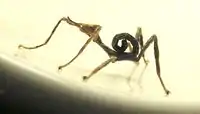| Extatosoma tiaratum | |
|---|---|
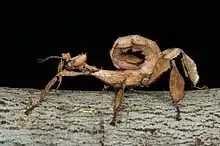 | |
| Scientific classification | |
| Domain: | Eukaryota |
| Kingdom: | Animalia |
| Phylum: | Arthropoda |
| Class: | Insecta |
| Order: | Phasmatodea |
| Family: | Phasmatidae |
| Subfamily: | Extatosomatinae |
| Genus: | Extatosoma |
| Species: | E. tiaratum |
| Binomial name | |
| Extatosoma tiaratum (Macleay, 1826) | |
Extatosoma tiaratum, commonly known as the spiny leaf insect, the giant prickly stick insect,[2] Macleay's spectre,[3] or the Australian walking stick, is a large species of Australian stick insect.[4][5] The species has the Phasmid Study Group number PSG9.[6]
Range
E. tiaratum is endemic to rainforests in Australia, with most of its range in eastern New South Wales and eastern Queensland, but it is also found in eastern Victoria (one old record) and South Australia (possibly introduced).[1][7] The closely related and similar E. popa is from New Guinea.[8]
Description
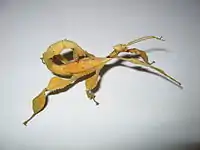
.jpg.webp)
Female adult E. tiaratum are covered with thorn-like spikes for defense and camouflage. Their long, rounded bodies grow to about 20 cm (8 in) long.[4][5] The females are further described as "heavy-bodied, brachypterous and having numerous spines and integumental expansions on the face and legs, including a tuft of spines on the conical occiput of the hypognathous head".[9] As mentioned, the wings of the female are too small for flying, especially when she is gravid.[2]
Exhibiting the sexual dimorphism of many similar insects (particularly other phasmids as well as mantises), males are small and thinner, growing only about 11 cm (4.5 in) in length and have three ocelli. Males lack the thorny growths except for spikes around their faces. They have long wings and are good flyers who readily take to the air if disturbed or in search of females.[4][10]
Anti-predator adaptations
Threat behaviour
Both sexes, when threatened, adopt a threat pose, standing on the front and middle legs, pointing their abdomen up or to the side in a sort of "scorpion" pose. They fold back their legs to defend themselves if anything comes in contact with their abdomen; the pincer movement with the sharp spines on the rear legs can puncture human skin. Adults make clicking sounds and can release a defensive odor reminiscent of toffee. Males may attempt to startle predators by flashing their wings open.[4][11]
Camouflage
E. tiaratum makes use of both passive and active camouflage. It adopts a curved pose when it hangs inverted amongst foliage with "its highly procryptic abdomen curled over its back."[3] Individual E. tiaratum vary in color and appear brown, mottled brown, green, reddish, cream, yellowish, or entirely white.[3][9]
Like many stick insects, E. tiaratum actively sways back and forth or side to side when disturbed or when there is a gust of wind, with a frequency distribution like foliage rustling in the wind. The swaying behaviour may be motion crypsis, preventing detection by predators, or motion masquerade, promoting misclassification (as something other than prey), or a combination of the two.[2][12]
Mimicry
Newly hatched E. tiaratum nymphs are ant mimics and resemble the insects in whose nest they are born. Their aposematic pattern—orange head, white collar, the rest black—mimics the ant genus Leptomyrmex and makes them appear toxic. Although most adult stick insects are notoriously slow, these nymphs are speedy, active, and quickly make their way to the trees. Their locomotion slows when they moult into their second and subsequent instars. Females acquire their distinctive spiky appearance through additional moults.[2][4][9]
Reproduction
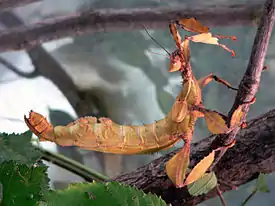
E. tiaratum typically reproduce through sexual reproduction and produce eggs that hatch four months later. When no males are present in the population, this stick insect exhibits parthenogenesis instead. Eggs laid without fertilization take up to nine months to hatch and produce only females. In either cases, the female "flicks" her eggs, swinging her tail, up to several feet to land on the forest floor. These eggs must be kept relatively cool - under 25 °C - or they are unlikely to hatch.[3][4]
The outside material of E. tiaratum eggs consists of lipids and other organic compounds that ants identify as food. They carry these eggs to their colony, consume the edible outer portion, and dump the intact eggs into their waste piles. Luckily for captive breeding, the ants eating the edible outer layer is not crucial to development, so they will hatch just as healthy without the need for any removal of the outer layer, which is not easily visible.[4][9]
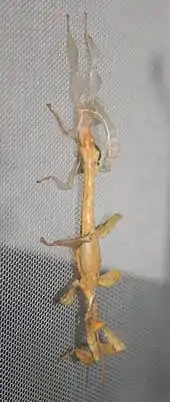
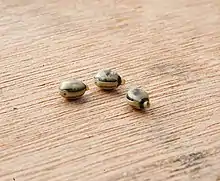
Cultivation
.png.webp)
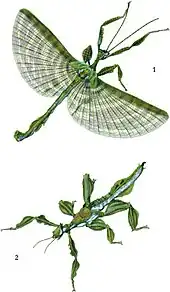
This species is relatively common in captivity. It is used in laboratories, kept for projects in schools (as is Carausius morosus[2]), and is a popular pet among breeders of exotic insects in North America and Europe. One breeder advises specifically "For a stick insect with body length 127mm, to keep 2 adult females, you need a cage at least 600mm high, 300mm deep and 300mm wide."[3]
Although the gestation period of their eggs is several months long, they are prolific breeders. A breeder notes that because of this insect's habit of flicking its eggs, one can "hear them clicking against the glass" of their terraria.[3] Some breeders in the United Kingdom, concerned with the negative effects of inbreeding on the vitality of their stock, have introduced new genes from abroad.[2]
Females live to about 18 months old, males to only 6–8 months.[13]
Diet
E. tiaratum are herbivores and although they thrive on Eucalyptus which is their native food, breeders abroad recommend feeding them bayberry, bramble, hawthorn, hazel, oak, photinia, raspberry, rose, and salmon berry (red or yellow) and guava.[3][14]
[4] Although they survive well on non-eucalypt leaves, they don't always grow as large or retain the same natural colour.[13]
Defense
E. tiaratum are incapable of bites and stings and rely solely on passive defense and camouflage. Some predators (such as mantids) have good vision, and can see the most camouflaged animals. When threatened, spiny leaf insects assume an aggressive posture such as rearing up. Females have a tough, spiky exoskeleton while males are winged and can fly away from danger. All adults have glands under that spray a colorless toffee-like odor which is pleasant to humans, but deters most predators.[15][16]
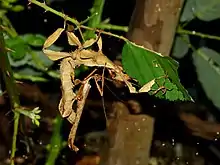
References
- 1 2 Rudolf, E. & Brock (2017). "Extatosoma tiaratum". IUCN Red List of Threatened Species. 2017: e.T80201037A104413678. doi:10.2305/IUCN.UK.2017-3.RLTS.T80201037A104413678.en. Retrieved 22 September 2022.
- 1 2 3 4 5 6 "Extatosoma tiaratum tiaratum* (Macleay, 1827), "Macleay's Spectre/ Giant Prickly Stick Insect"". Archived from the original on 2007-07-08. Retrieved 2018-09-21.
- 1 2 3 4 5 6 7 Peter Miller (12 May 2003). "Extatosoma tiaratum (Macleay, 1826)". Archived from the original on 3 April 2012. Retrieved 27 November 2006.
- 1 2 3 4 5 6 7 8 "Giant Prickly Leaf Bug (Extatosoma tiaratum) (PSG-9)". PhasmidsinCyberspace.com. 2005. Archived from the original on 2015-09-24.
- 1 2 Rune Midtgaard. "Giant Prickly Stick Insect". Archived from the original on 2010-12-21. Retrieved 2008-08-08.
- ↑ "Species Information - Phasmid Study Group". phasmidstudygroup.org. Retrieved 2021-05-11.
- ↑ "species Extatosoma tiaratum (Macleay, 1826)". phasmida.speciesfile.org. Retrieved 8 August 2023.
- ↑ "species Extatosoma popa Stål, 1875". phasmida.speciesfile.org. Retrieved 8 August 2023.
- 1 2 3 4 Key, K.H.L. (1991). "Phasmatodea (Stick-insects)". In CSIRO (ed.). The Insects of Australia. A textbook for students and research workers. Melbourne: Melbourne University Press, Vol. 1, 2nd Edn. pp. 394–404.
- ↑ Rentz, D.C.F. (1996). "16: Phasmatodea: Leaf and Stick Insects". Grasshopper Country. pp. 244–257.
- ↑ Brock, Paul D.; Hasenpusch, Jack W. (2009). The Complete Field Guide to Stick and Leaf Insects of Australia. Csiro Publishing. pp. 126–128. ISBN 978-0-643-09418-5.
- ↑ Bian, Xue; Elgar, Mark A.; Peters, Richard A. (2016). "The swaying behavior of Extatosoma tiaratum : motion camouflage in a stick insect?". Behavioral Ecology. 27 (1): 83–92. doi:10.1093/beheco/arv125.
- 1 2 "Spiny Leaf Insects". ABC. Archived from the original on 2016-03-29. Retrieved 2018-09-21.
- ↑ Supply, Reptile (2021-09-13). "How to Care for Your Giant Prickly Stick Insect". ReptileSupply.com. Retrieved 2022-08-04.
- ↑ Jugglebug. "How to keep a pet spiny leaf insect". Autodesk, Inc.
- ↑ "Stick/Leaf Insects Care" (PDF). P & K Pets. Archived from the original (PDF) on 2013-10-19. Retrieved 2013-10-19.
External links
- Phasmid Study Group: Extatosoma tiaratum Retrieved 21 March 2021.

